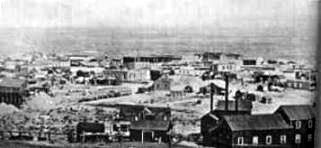On Oct. 26, 1881 at 3:00 in the afternoon a gunfight broke out in Tombstone, Arizona Territory, with Marshall Wyatt Earp, Morgan Earp, Virgil Earp and Doc Holliday on one side and the Clanton brothers and Mclaury brothers on the other side. This gunfight would later be known as the "Gunfight at the OK Corral". (1)
Tombstone, Arizona Territory (2)
On Dec 25, 1881 in Waco, TX, The Waco Daily Examiner published a newspaper where Sanger Brothers was advertising clothes, boots, shoes, and carpet for sale and R.S. Mills advertised "Staple and Fancy Groceries". (Sanger Brothers was started by Isaac Sanger in 1857 in McKinney, TX and later was joined by his brothers to open stores along major railroad lines in Texas. Sanger Brothers would later become Sanger-Harris a prominent part of Dallas business and Texas history. (3))
The Waco Daily Examiner. (Waco, TX), Sunday, Dec. 25, 1881. (4)
"The Meixner family settled on the Brazos River bottoms. I am sure that they were very poor and that they had to live in impoverished quarters. Dad said that the water snakes, perhaps some of the poisonous, would slither round on the rafters and often fall down on the beds. It makes one shudder to think of such uncomfortable conditions." This quote is what my dad wrote in his unpublished book titled "Memoirs of Robert Harmon Meixner, Sr., July 10, 1910 - June 13, 1994" describing what his dad had told him about living on the Brazos River bottoms. One article I read about Robertson County confirmed there were ..."numerous snake species, including the poisonous copperhead, cottonmouth, coral snake, and rattlesnake"... (5)
Rasche Hearne's home was located in the community of Sutton 5 miles south of Hearne, TX. (7) Hearne traveled from his home to the several farms located in the bottom lands. I assume the Meixners lived in the bottoms near the area where they worked. I don't know for sure that Frank Meixner worked as a farm laborer. Claudia suggested he might have worked as a butcher for the plantation, since that is the occupation listed in the ship's records when he came to the U.S.
As you look at the map below, Hearne is located in the center of the map. The light area from upper left toward the lower right is part of the Brazos River bottom lands. I'm guessing that somewhere to the left of Hearne and Sutton would be where the Meixner family lived.
Google Earth Maps.
Up to this point it seems to me the Meixner family's new life in America had been pretty difficult. Unfortunately it would get worse.
In the 1800's typhoid was very prevalent. Typhoid fever is an acute illness associated with fever that is most often caused by the Salmonella typhi bacteria. The bacteria are deposited in water or food by a human carrier and are then spread to other people in the area. Symptoms include: confusion, abdominal pain, generalized aches and pain, fever (often up to 104 degrees), intestinal bleeding, diarrhea, etc. Death occurred from overwhelming infection, pneumonia, and intestinal bleeding. Prior to antibiotics the fatality rate was 20% or more. From 1880 to 1920 typhoid killed an estimated one million people. (8)
On Good Friday, April 7, 1882, all the family was sick with typhoid fever. The two little girls, 6 year old Herminia and 7 year old Theresia, died. (9)
Claudia said her mother "heard it was raining the day they tried to bury them and the little coffins floated up in the graves". "Frank was ill with the fever and kept calling for one of them to bring him some water, not knowing that they were dead." My dad wrote in his book: "All of the Meixner family were in bed with the smallpox." (He remembered hearing it was smallpox though typhoid seems to me to be more likely the cause.) "Two of the girls died. There was no help to be had so grandfather Meixner had to bury his own daughters."
In two weeks: Another Move for the Meixner Family
References:
1) & 2) Wikipedia.org, wikipedia/gunfight_at_the_O.K._corral.
3) Diana J. Kleiner, "SANGER BROTHERS," Handbook of Texas Online (http://www.tshaonline.org/handbook/online/articles/ijsqi), accessed September 22, 2012. Published by the Texas State Historical Association.
4) The Waco Daily Examiner. (Waco,Tex.), Vol. 13, No. 249, Ed. 1, Sunday, December 25, 1881, Newspaper; digital images, (http://texashistory.unt.edu/ ark:/67531/metapth112235/ : accessed August 23, 2012), University of North Texas Libraries, The Portal to Texas History, http://texashistory.unt.edu; crediting UNT Libraries, Denton, Texas.
5) James L. Hailey and Christoher Long, "ROBERTSON COUNTY," Handbook of Texas Online (http://www.tshaonline.org/handbook/online/articles/hcr09), accessed August 20,2012. Published by the Texas State Historical Associaton.
6) http://www.rootsweb.ancestry.com/~txrober2/Carson_Thesis/ CarsonChapterV.html
7) Richard Allen Burns, "Sutton, TX", Handbook of Texas online (http://www.tshaoline.org/handbook/online/articles/hvsdf), accessed September 09, 2012. Published by the Texas State Historical Association.
8) www.medicinenet.com
9) Family sources said the girls died on Good Friday in 1882. According to www.timeanddate.com Good Friday fell on April 7 in 1882.



No comments:
Post a Comment
Please include your e-mail address.
Note: Only a member of this blog may post a comment.